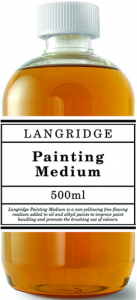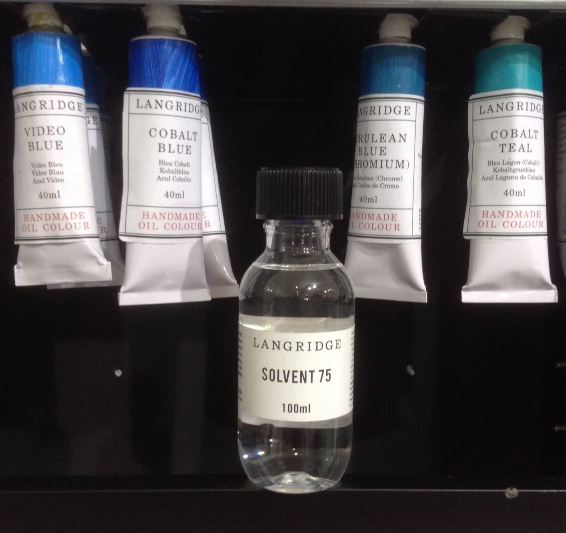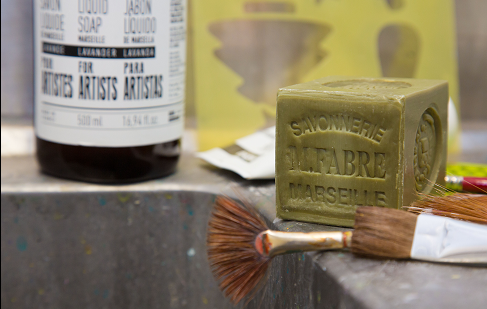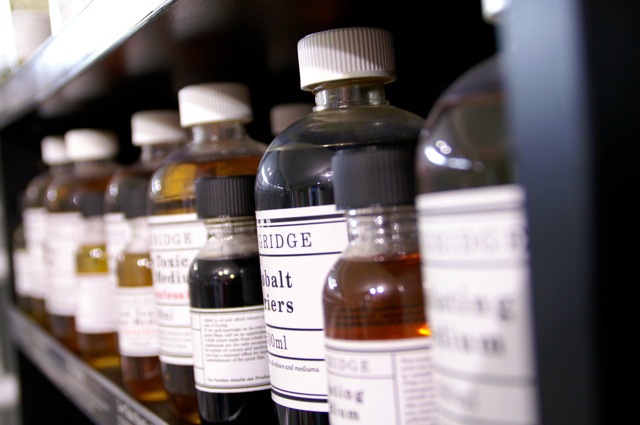Art Spectrum, Gamblin, Golden, Langridge, NAM and a few other interesting products in other brands but as the list is long so… please scroll down.
So, first things first… Primers or gessos: are coats applied to the support to provide a desirable surface on which to paint. Most grounds are white to offer the brightest reflecting surface for light to act upon (but we also stock black, gray and transparent gesso). Acrylic primers can be painted directly onto raw canvas. Do not apply over glue sizing. Oil primers need to have a coat of glue size applied first to protect the raw canvas underneath.
- Golden has a top quality black and white gesso + sandable hard gesso you can sand back to super smooth surface.
- Langridge offers the three sorts: Acrylic Primer (in white and clear): A superior high resin, low chalk content primer with excellent hiding power due to high Titanium White loading. Suitable for oils and acrylics, it can be applied to a wide range of surfaces including raw canvas, wood and paper. Oil Primer: A traditional linseed oil based oil primer. Produces a high quality white surface with good tooth and flexibility for oil painting. Reduces sinking in of colours and imparts good luminosity. Must be used on a pre-sized support (ie. rabbit skin glue or archival PVA).
- NAM has a good well priced gesso (we stock up to 4 litre buckets)
Then what you need to paint: Mediums and Solvents…
- Art Spectrum : Mediums and Solvents…
When one layer of oil paint contains an equal amount of oil as the next layer, the top layer will dry while the bottom layer will be deprived of oxygen and remain wet. This will cause wrinkling and eventually cracking. To prevent this problem, use the Painting Medium No. 1 first and then Medium No. 2 for subsequent layers. This will give an even tension throughout the painting. Painting Medium No. 3 is viscous and ‘fatter’ for those who like a heavier medium. It should be used over the leaner mediums.
- Medium No. 1 contains the minimum formulated account of Stand Oil to cross-link the medium and the oil paint, preventing the breakdown of the vehicle and ensuring permanency. No prior mixing is required. It can be used to obtain even watercolour effects. Two thin coats of oil paint will give a better coverage than one thick layer and will provide a better surface for future work. Medium No. 1 dries over night. (Another recommended use of Medium No. 1 is as a ‘sealer’ or cushion over acrylic primed canvas. Simply coat the acrylic gesso with the medium prior to use and allow it to dry, or work on it wet. )
- Medium No. 2 is a fat medium. It should be mixed with the oil paint as the layers of painting develop. It has some of the properties of a glazing medium but it is preferable to use Art Spectrum 24-hour Glazing Medium if very thin veils of colour are desired.
- Medium No. 3 is a thicker medium yet. It is for painters who like a heavier, more viscous, medium. It is ideal for artists who paint in many layers.
- Liquol: Medium No. 4 is a quick drying, transparent painting and glazing medium. Excellent for mulltiple glazes, where it will give great depth and subtlety of colour. Can be painted wet on wet, or left to dry before overpainting. Mix thorougly with oil paint on the palette before applying.
- Glazing gel becomes liquid when mixed with paint. Suitable for moderate impasto and glazing. Dries to a shoft sheen quickly.
- For those that are weary of solvents’ smell you can go to the alternative Odourless lean and fat mediums or try the Wax medium (a mixture of oil and wax to achieve transluscent effects. Unsuitable for impasto. Dries to a satin finish).
Art Spectrum also has a wide range of turps: gum, artist’s, odourless, citrus which we stock.
- Langridge : Oils, mediums, glazes, solvents and some words of advice
Drying oils act as agglomerating binders for artists’ oil paint and provide body to the brushstroke as the colours are spread out. Selection of the appropriate oil can alter the working quality of the paint. Performance differences include paste consistency, texture, effect on paint shades, desired drying time and mechanical strength of the paint film. Oils dry by absorbing oxygen, turning into a solid, non-reversible film, a process taking up to six months.
- Cold Pressed Linseed Oil: Pale golden oil used as a traditional binder for grinding oil colours. When used the paint produces a pronounced ‘suede’ brush mark. Cold Pressed Linseed Oil has increased wetting power and imparts flexibility to paint films. Use sparingly as a medium as linseed has a tendency to yellow with age.
- Alkalai Refined Linseed Oil: Highest quality Dutch linseed oil used as a medium for oil colours. Increases gloss and transparency. Adds a soft, ‘slippery’ quality when added to oil paints. Use sparingly as a medium as linseed has a tendency to yellow with age.
- Stand Oil: Non-yellowing oil for use in all oil mediums. Thick and honey-like oil, it will give enamel-like qualities to paint. Too thick to use straight, it should be diluted with solvent. Slow drying to allow alla prima painting. Reduces brush marks. Dries to a tough flexible film.
 Mediums To help the application of colours when underpainting, the colours are often thinned to a more fluid consistency. Avoid using only a solvent as this often leads to underbound oil paint that will crack or dust off. Some oil paints which are slow driers should be avoided in underpainting because the underlayers will remain mobile and move as they dry. This causes cracking of the fast drying colours which may be used on top of them. Pigments to avoid in underpainting: Cadmiums, Ivory and Lamp Black, Zinc White, Arylide Yellow.
Mediums To help the application of colours when underpainting, the colours are often thinned to a more fluid consistency. Avoid using only a solvent as this often leads to underbound oil paint that will crack or dust off. Some oil paints which are slow driers should be avoided in underpainting because the underlayers will remain mobile and move as they dry. This causes cracking of the fast drying colours which may be used on top of them. Pigments to avoid in underpainting: Cadmiums, Ivory and Lamp Black, Zinc White, Arylide Yellow.
- Langridge’s Low Toxic Underpainting Medium is a lean medium to be used for that ‘first-sketch’ in painting. It allows the artist to confidently apply colours that will dry rapidly, yet not sink-in and dull off. It has low oil content for rapid drying, minimising chances of cracking when overpainting with full strength colours. Stand Oil base ensures non-yellowing of artwork.
- Using Low Toxic Paint Medium the artist can improve the flow of oil colours and is especially useful for working on paintings in one or two sessions. It has a pronounced ‘grab’ when still wet and is perfect for a wet-into-wet technique. The use of the smallest amount of medium is always desired as all permanent mediums contain percentages of drying oil, normally Linseed, Stand or Safflower. It is the oil that will yellow or darken with age thereby discolouring the artwork, therefore the use of a non-yellowing oil such as Stand Oil is desired. Langridge Painting Medium is a free-flowing medium for oils that improves paint handling. Quickly dries to a tack but remains fresh so that it may still be painted into. Perfect for wet on wet technique. Stand Oil base ensures non-yellowing of artwork. Pale colours stay bright while deep tones are enriched.
- Flow Medium: Flow medium based on odourless low toxic solvent. Dramatically reduces the exposure to more harmful solvents. Tacks-up with an open surface perfect for wet in wet technique. Pales colours stay bright while deep tones are enriched.
- Low Toxic Gel Medium: Free-flowing medium for oils that improves paint handling. Quickly dries to a tack but remains fresh so that it may still be painted into. Perfect for wet on wet technique. Stand Oil base ensures non-yellowing of artwork. Pale colours stay bright while deep tones are enriched.
- Isolating Medium: Non reversible, oil based medium to even out the reflective finish of a painting. Dries to a non yellowing, gloss finish so that the consequent application of a gloss, satin or mat picture varnish can be achieved more easily. Enriches dull areas of paint surface due to “sinking in” of preceding paint fields.
- Wax Painting Paste: Wax medium with a thick, smooth, buttery consistency. Highly stable impasto medium that keeps colours bright. The correct medium for use in thick impasto painting. Wax Painting Paste is added to oil paint to give extra bulk without loss of opacity. It tends to give a mat surface as the refined beeswax content has a matting effect when used in sufficient quantities. It is advisable to use this wax medium for impasto work rather than the use of gelled oil mediums as these have a tendency for dramatic yellowing and surface crawl.
- Safe-gel: A non-toxic solvent free, thick gel medium which extends oil colours while maintaining structure and a soft buttery consistency. Slow drying.
Glazes are added to create thin, but permanent, veils of paint. The resin content creates optical depth similar to a colour varnish. Glaze Medium should be used when working on the top layers of the painting and helps create spatial effects allowing subtle alterations of the existing passages of paint. It will tend to make the paint more transparent so that gentle gradations of light and shade can be achieved.
- Glaze Medium: A resin rich oil medium that gives oil colours increased translucency. Perfect for the creation of optical depth and soft suffusion of colour. Used for traditional thin glazes and fine detail work. Stand Oil base ensures non-yellowing.
- Oil Glazing Gel: A fast drying medium that gives a lasting brilliance to oils. Soft gel consistency designed for more robust glazing and as such is not designed as an impasto medium. Extends colours whilst holding brush marks.
Solvents dissolve and mix with oils and resins to reduce the viscosity of paints and varnish. They are also used for the removal of oils, paint and varnishes. Solvents for artists materials must not react chemically with the materials with which they are mixed, must not have a destructive action on the underpainting and should evaporate completely, leaving no residue.
- Distilled Gum Turpentine: Natural diluent and solvent for oil colours and varnishes. Distilled from the resin of tapped Gum Thus Pine. Greater wetting power than other solvents. Has a pleasant pine odour.
- Odourless Solvent: A safer alternative to traditional solvents with less toxicity. Completely odourless. Ideal replacement for artists concerned about exposure to harmful solvents.
- Artists White Spirit: Economical all purpose solvent. Ideal for cleaning brushes as it has a strong detergent action. Used heavily it will mat paint. Has a distinctive petroleum smell.
- Gamblin’s Gamsol is the safest 100% pure odorless mineral spirit available (its harmful aromatic components have been removed!). It also enables printmakers to easily modify inks and is great for every artist’s studio clean-up, eliminating the need for stronger solvents.
- Langridge’s Solvent 75 is the world’s lowest toxicity studio solvent for oil
 painting. It is constructed from 100% pure, highly refined odourless mineral spirit and is NOT classified as Dangerous Goods so you can take it with you on the plane! It dramatically reduces respiratory exposure to harmful solvents and virtually no skin irritations have been observed.
painting. It is constructed from 100% pure, highly refined odourless mineral spirit and is NOT classified as Dangerous Goods so you can take it with you on the plane! It dramatically reduces respiratory exposure to harmful solvents and virtually no skin irritations have been observed.
… then some other interesting or strange products you might want to try…
Cobalt Drier: Siccative made with cobalt naphthenate. Acts as a drier for all oil colours and mediums. To be used sparingly as its overuse will destroy paint films.
Fine White Marble Dust: Extra fine, dense inert filler for paints.
Gilders Whiting: Natural chalk. Calcium Carbonate. Soft filler for paints.
Insinglass: A fish adhesive used in the repairing or mounting of paper and objects when warm application is prohibitive
Laropal K80: Dissolved in White Spirit, this colourless synthetic Ketone resin makes the highest quality picture varnish.
Oil of Spike Lavender: the ultimate less-toxic painting medium! Adding a small amount to your oil paints will help the brush move smoothly and accurately. It will enhance your glazes, and make working with details easier. Sometimes artists actually dip the brush directly in the Spike Oil so that the brush strokes are smooth. Only a small amount is needed – a drop or two at a time.
Pumice Powder: Fine gray inert filler. Adds texture to paints & mediums.
Rabbit Skin Glue (Granules): Refined animal glue size. For sizing canvasses prior to oil priming thereby preventing canvas rot.
Refined Beeswax (Beads): Used in oil mediums to add body. Matting agent for oil mediums and varnishes. Binder in true encaustic.
and finally…

Chroma Incredible Brush cleaner: This cleaner braggs that it can break through hardened acrylic, oil or lacquer on natural and synthetic paint brushes and… it does just that!
Langridge Safe Clean-up: A solvent free, non-toxic hand and brush cleaner. Safely removes Oil and Acrylic paint. By placing brushes in Safe-Clean-up overnight it will even remove dried paint.
“The Masters” Clean-up: Non toxic. Comes in a bar for the hands and a tub for the brushes.
and last but not least some olive oil soap (in blocks) which really works… an all natural way to take care of your hands and brushes!

